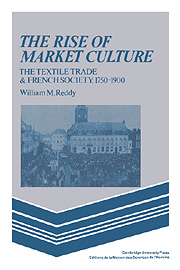Book contents
- Frontmatter
- Contents
- List of figures and maps
- List of abbreviations
- Preface
- Introduction
- Part One A world without entrepreneurs, 1750–1815
- Part Two Uses of the market idea, 1816–1851
- 4 The first crisis of management
- 5 Spinners on guard
- 6 Visions of subsistence
- 7 A search for identity
- Part Three Unquestioned assumptions, 1852–1904
- Conclusion
- Notes
- Bibliographical note
- Index
7 - A search for identity
from Part Two - Uses of the market idea, 1816–1851
Published online by Cambridge University Press: 30 September 2009
- Frontmatter
- Contents
- List of figures and maps
- List of abbreviations
- Preface
- Introduction
- Part One A world without entrepreneurs, 1750–1815
- Part Two Uses of the market idea, 1816–1851
- 4 The first crisis of management
- 5 Spinners on guard
- 6 Visions of subsistence
- 7 A search for identity
- Part Three Unquestioned assumptions, 1852–1904
- Conclusion
- Notes
- Bibliographical note
- Index
Summary
Two German historians, Martin Henkel and Rolf Taubert, recently issued a stinging critique of what they consider to be a teleological bias that plagues historical research on conflict in industrial society. Unions, strikes, and collective bargaining are implicitly taken as the proper forms of working-class action; all other forms are viewed as either backward looking or forward looking depending on the extent to which they resemble the twentieth-century end point. Henkel and Taubert are particularly good at tracking down the subtle wordings, the condescending tones, and tendentious metaphors by which such judgments are often expressed. But the justice of their critique is already widely acknowledged. It is widely admitted that, in early forms of protest like food riots or machine breaking, the people involved moved in a social context entirely different from that of twentieth-century wage laborers. Most now agree that protest from before about 1830 in Europe is not to be measured by twentieth-century norms.
Avoiding the teleological bias becomes a problem of an entirely different order, however, when one comes to examine the period after 1830, full of incidents of protest that bear close resemblance to modern-day strikes and of organizations that look very much like unions. There is a strong temptation to fall back on the idea that these incidents and organizations represent early, failed efforts by people who did not yet quite understand what they ought to do. After all unions, strikes, and collective bargaining did eventually become dominant. It is reasonable to assume, therefore, that at some point they became appropriate and that people then had to fumble around until they discovered the proper response.
- Type
- Chapter
- Information
- The Rise of Market CultureThe Textile Trade and French Society, 1750–1900, pp. 185 - 224Publisher: Cambridge University PressPrint publication year: 1984
- 1
- Cited by



